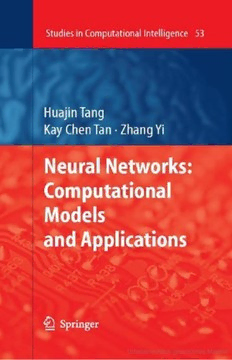Table Of ContentHuajinTang,KayChenTanandZhangYi
NeuralNetworks:ComputationalModelsandApplications
StudiesinComputationalIntelligence,Volume53
Editor-in-chief
Prof.JanuszKacprzyk
SystemsResearchInstitute
PolishAcademyofSciences
ul.Newelska6
01-447Warsaw
Poland
E-mail:kacprzyk@ibspan.waw.pl
Furthervolumesofthisseries Vol.43.FabriceGuillet,HowardJ.Hamilton(Eds.)
canbefoundonourhomepage: QualityMeasuresinDataMining,2007
springer.com ISBN978-3-540-44911-9
Vol.31.AjithAbraham,CrinaGrosan,VitorinoRamos Vol.44.NadiaNedjah,LuizadeMacedo
(Eds.) Mourelle,MarioNetoBorges,
StigmergicOptimization,2006 NivalNunesdeAlmeida(Eds.)
ISBN978-3-540-34689-0 IntelligentEducationalMachines,2007
ISBN978-3-540-44920-1
Vol.32.AkiraHirose
Complex-ValuedNeuralNetworks,2006 Vol.45.VladimirG.Ivancevic,TijanaT.Ivancevic
ISBN978-3-540-33456-9 Neuro-FuzzyAssociativeMachineryforComprehensive
BrainandCognitionModeling,2007
Vol.33.MartinPelikan,KumaraSastry,Erick
ISBN978-3-540-47463-0
Cantu´-Paz(Eds.)
ScalableOptimizationviaProbabilistic Vol.46.ValentinaZharkova,LakhmiC.Jain
Modeling,2006 ArtificialIntelligenceinRecognitionandClassification
ISBN978-3-540-34953-2 ofAstrophysicalandMedicalImages,2007
Vol.34.AjithAbraham,CrinaGrosan,Vitorino ISBN978-3-540-47511-8
Ramos(Eds.) Vol.47.S.Sumathi,S.Esakkirajan
SwarmIntelligenceinDataMining,2006 FundamentalsofRelationalDatabaseManagement
ISBN978-3-540-34955-6 Systems,2007
Vol.35.KeChen,LipoWang(Eds.) ISBN978-3-540-48397-7
TrendsinNeuralComputation,2007 Vol.48.H.Yoshida(Ed.)
ISBN978-3-540-36121-3 AdvancedComputationalIntelligenceParadigms
Vol.36.IldarBatyrshin,JanuszKacprzyk,Leonid inHealthcare,2007
Sheremetor,LotfiA.Zadeh(Eds.) ISBN978-3-540-47523-1
Preception-basedDataMiningandDecisionMaking Vol.49.KeshavP.Dahal,KayChenTan,PeterI.Cowling
inEconomicsandFinance,2006 (Eds.)
ISBN978-3-540-36244-9 EvolutionaryScheduling,2007
Vol.37.JieLu,DaRuan,GuangquanZhang(Eds.) ISBN978-3-540-48582-7
E-ServiceIntelligence,2007 Vol.50.NadiaNedjah,LeandrodosSantosCoelho,
ISBN978-3-540-37015-4 LuizadeMacedoMourelle(Eds.)
Vol.38.ArtLew,HolgerMauch MobileRobots:TheEvolutionaryApproach,2007
DynamicProgramming,2007 ISBN978-3-540-49719-6
ISBN978-3-540-37013-0
Vol.51.ShengxiangYang,YewSoonOng,YaochuJin
Vol.39.GregoryLevitin(Ed.) Honda(Eds.)
ComputationalIntelligenceinReliabilityEngineering, EvolutionaryComputationinDynamicandUncertain
2007 Environment,2007
ISBN978-3-540-37367-4 ISBN978-3-540-49772-1
Vol.40.GregoryLevitin(Ed.) Vol.52.AbrahamKandel,HorstBunke,MarkLast(Eds.)
ComputationalIntelligenceinReliabilityEngineering, AppliedGraphTheoryinComputerVisionandPattern
2007 Recognition,2007
ISBN978-3-540-37371-1 ISBN978-3-540-68019-2
Vol.41.MukeshKhare,S.M.ShivaNagendra(Eds.)
Vol.53.HuajinTang,KayChenTan,ZhangYi
ArtificialNeuralNetworksinVehicularPollution
NeuralNetworks:ComputationalModels
Modelling,2007
andApplications,2007
ISBN978-3-540-37417-6
ISBN978-3-540-69225-6
Vol.42.BerndJ.Kra¨mer,WolfgangA.Halang(Eds.)
ContributionstoUbiquitousComputing,2007
ISBN978-3-540-44909-6
Huajin Tang
Kay Chen Tan
Zhang Yi
Neural Networks:
Computational Models
and Applications
With 103 Figures and 27 Tables
Dr.HuajinTang Prof.KayChenTan
QueenslandBrainInstitute DepartmentofElectrical
UniversityofQueensland andComputerEngineering
QLD4072Australia NationalUniversityofSingapore
E-mail:huajin.tang@ieee.org 4EngineeringDrive3
Singapore117576
E-mail:eletankc@nus.edu.sq
Prof.ZhangYi
ComputationalIntelligenceLaboratory
SchoolofComputerScience
andEngineering
UniversityofElectronicScience
andTechnologyofChina
Chengdu610054P.R.China
E-mail:zhangyi@uestc.edu.cn
LibraryofCongressControlNumber:2006939344
ISSNprintedition:1860-949X
ISSNelectronicedition:1860-9503
ISBN-10 3-540-69225-8SpringerBerlinHeidelbergNewYork
ISBN-13 978-3-540-69225-6SpringerBerlinHeidelbergNewYork
Thisworkissubjecttocopyright.Allrightsarereserved,whetherthewholeorpartofthematerial
isconcerned,specificallytherightsoftranslation,reprinting,reuseofillustrations,recitation,broad-
casting,reproductiononmicrofilmorinanyotherway,andstorageindatabanks.Duplicationof
thispublicationorpartsthereofispermittedonlyundertheprovisionsoftheGermanCopyrightLaw
ofSeptember9,1965,initscurrentversion,andpermissionforusemustalwaysbeobtainedfrom
Springer-Verlag.ViolationsareliabletoprosecutionundertheGermanCopyrightLaw.
SpringerisapartofSpringerScience+BusinessMedia
springer.com
(cid:176)c Springer-VerlagBerlinHeidelberg2007
Theuseofgeneraldescriptivenames,registerednames,trademarks,etc.inthispublicationdoesnot
imply, even in the absence of a specific statement, that such names are exempt from the relevant
protectivelawsandregulationsandthereforefreeforgeneraluse.
Coverdesign:deblik,Berlin
TypesettingbytheauthorsusingaSpringerLATEXmacropackage
Printedonacid-freepaper SPIN:11544272 89/SPi 543210
To our family, for their loves and supports.
Huajin Tang
Kay Chen Tan
Zhang Yi
Preface
Artificial neural networks, or simply called neural networks, refer to the
various mathematical models of human brain functions such as perception,
computationandmemory.Itisafascinatingscientificchallengeofourtimeto
understand how the human brain works. Modeling neural networks facili-
tates us in investigating the information processing occurred in brain in a
mathematical or computational manner. On this manifold, the complexity
and capability of modeled neural networks rely on our present understand-
ing of biological neural systems. On the other hand, neural networks provide
efficient computation methods in making intelligent machines in multidisci-
plinary fields, e.g., computational intelligence, robotics and computer vision.
Inthepasttwodecades,researchinneuralnetworkshaswitnessedagreat
deal of accomplishments in the areas of theoretical analysis, mathematical
modeling and engineering application. This book does not intend to cover all
the advances in all aspects, and for it is formidable even in attempting to do
so. Significant efforts are devoted to present the recent discoveries that the
authorshavemademainlyinfeedforwardneuralnetworks,recurrentnetworks
and bio-inspired recurrent network studies. The covered topics include learn-
ingalgorithm,neuro-dynamicsanalysis,optimizationandsensoryinformation
processing, etc. In writing, the authors especially hope the book to be helpful
for the readers getting familiar with general methodologies of research in the
neural network areas, and to inspire new ideas in the concerned topics.
We received significant support and assistance from the Department of
Electrical and Computer Engineering, and we are especially grateful to the
colleagues in the Control & Simulation Lab and Zhang Yi’s CI lab, where
many simulation experiments and meaningful work were carried out.
We are grateful to a lot of people who helped us directly or indirectly. We
are extremely grateful to the following professors for their valuable sugges-
tions, continuous encouragements and constructive criticisms: Ben M. Chen,
Jian-Xin Xu, National University of Singapore; Weinian Zhang, Sichuan Uni-
versity, China; C.S. Poon, Massachusetts Institute of Technology; Xin Yao,
University of Birmingham, UK; Hussein A. Abbass, University of New South
VIII Preface
Wales, Australian Defence Force Academy Campus. We are very thankful to
Eujin Teoh for his careful reading of the draft.
HuajinTangwouldliketothankGeoffreyGoodhill,UniversityofQueens-
land,forhisvaluablehelps.ZhangYiwouldliketothankHongQu,JianChen
Lv and Lei Zhang, University of Electronic Science and Technology of China,
for their useful discussions.
Australia Huajin Tang
Singapore Kay Chen Tan
China Zhang Yi
May 2006
Contents
List of Figures.................................................XV
List of Tables ..................................................XXI
1 Introduction............................................... 1
1.1 Backgrounds............................................ 1
1.1.1 Feed-forward Neural Networks ...................... 1
1.1.2 Recurrent Networks with Saturating Transfer
Functions ........................................ 2
1.1.3 Recurrent Networks with Nonsaturating Transfer
Functions ........................................ 4
1.2 Scopes ................................................. 5
1.3 Organization............................................ 6
2 Feedforward Neural Networks and Training Methods ...... 9
2.1 Introduction ............................................ 9
2.2 Error Back-propagation Algorithm......................... 9
2.3 Optimal Weight Initialization Method...................... 12
2.4 The Optimization-Layer-by-Layer Algorithm................ 14
2.4.1 Optimization of the Output Layer ................... 15
2.4.2 Optimization of the Hidden Layer ................... 16
2.5 Modified Error Back-Propagation Method .................. 18
3 New Dynamical Optimal Learning for Linear Multilayer
FNN ...................................................... 23
3.1 Introduction ............................................ 23
3.2 Preliminaries............................................ 24
3.3 The Dynamical Optimal Learning ......................... 25
3.4 Simulation Results....................................... 28
3.4.1 Function Mapping................................. 28
3.4.2 Pattern Recognition ............................... 30
X Contents
3.5 Discussions ............................................. 33
3.6 Conclusion ............................................. 33
4 Fundamentals of Dynamic Systems ........................ 35
4.1 Linear Systems and State Space ........................... 35
4.1.1 Linear Systems in R2 .............................. 35
4.1.2 Linear Systems in Rn.............................. 38
4.2 Nonlinear Systems....................................... 41
4.3 Stability, Convergence and Bounded-ness ................... 41
4.4 Analysis of Neuro-dynamics............................... 46
4.5 Limit Sets, Attractors and Limit Cycles .................... 51
5 Various Computational Models and Applications .......... 57
5.1 RNNs as a Linear and Nonlinear Programming Solver........ 57
5.1.1 Recurrent Neural Networks ......................... 58
5.1.2 Comparison with Genetic Algorithms ................ 59
5.2 RNN Models for Extracting Eigenvectors ................... 66
5.3 A Discrete-Time Winner-Takes-All Network ................ 68
5.4 A Winner-Takes-All Network with LT Neurons.............. 70
5.5 Competitive-Layer Model for Feature Binding
and Segmentation ....................................... 74
5.6 A Neural Model of Contour Integration .................... 76
5.7 Scene Segmentation Based on Temporal Correlation ......... 77
6 Convergence Analysis of Discrete Time RNNs for Linear
Variational Inequality Problem ............................ 81
6.1 Introduction ............................................ 81
6.2 Preliminaries............................................ 82
6.3 Convergence Analysis: A is a Positive Semidefinite Matrix .... 83
6.4 Convergence Analysis: A is a Positive Definite Matrix ........ 85
6.5 Discussions and Simulations .............................. 87
6.6 Conclusions............................................. 96
7 Parameter Settings of Hopfield Networks Applied
to Traveling Salesman Problems ........................... 99
7.1 Introduction ............................................ 99
7.2 TSP Mapping and CHN Model............................100
7.3 The Enhanced Lyapunov Function for Mapping TSP.........102
7.4 Stability Based Analysis for Network’s Activities ............104
7.5 Suppression of Spurious States ............................105
7.6 Setting of Parameters ....................................112
7.7 Simulation Results and Discussions ........................112
7.8 Conclusion .............................................115

